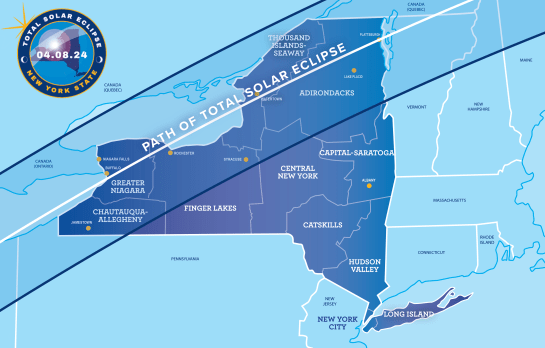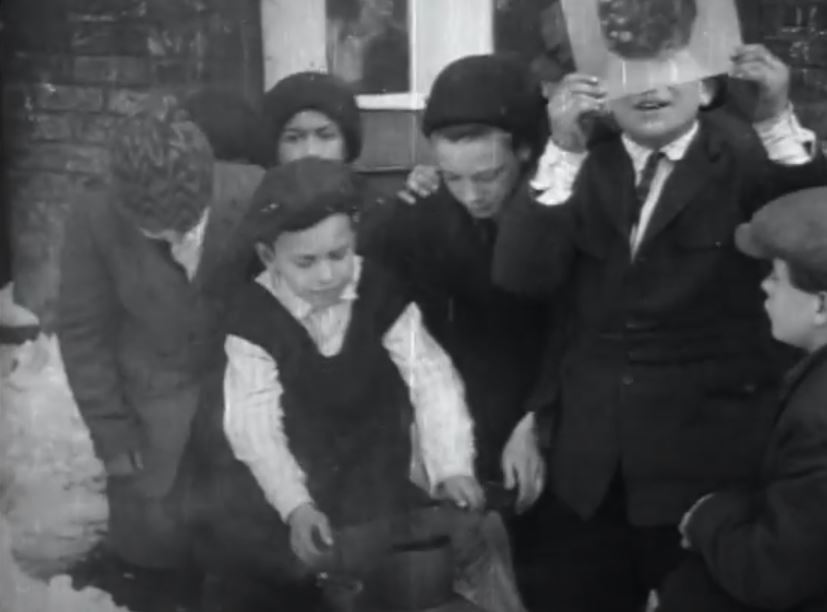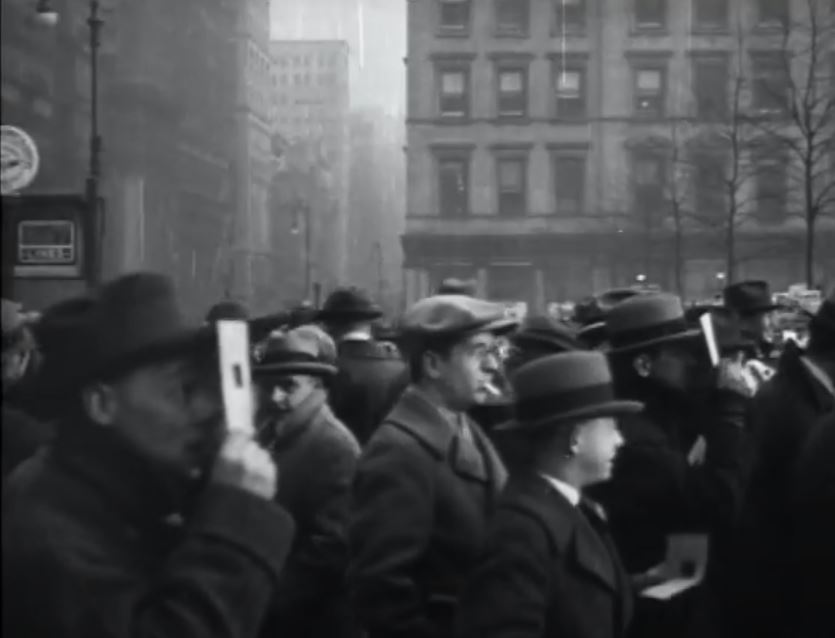Many of us remember the last total solar eclipse in the United States, known as the Great American Eclipse in August 2017. The news coverage talked of the path of totality which travelled from coast to coast, starting in Oregon and arcing south across the country through South Carolina. Those who remained here in New York were treated to a view of between 59-75 percent obscuration (covering) of the sun as the moon passed between the sun and Earth. While it was definitely a national event, New York didn’t get the front-row seats that being in an eclipse’s path of totality provides.
Thankfully, many New Yorkers will soon have the opportunity to see this celestial wonder for themselves from their own backyards or local parks. On April 8, 2024, another total solar eclipse will pass from Mexico through parts of 14 different states and into Canada. This time, New York is in the eclipse’s path.

Some people have been looking forward to the 2024 total solar eclipse for years, some for decades! But all of this anticipation has some of us looking backwards to the last total solar eclipse that passed through the skies of New York State in 1925.

So much has changed in the world in the 99 years since a total solar eclipse graced the skies of New York. Take a step back in time to revel in the eclipse of 1925 with this hypothetical account from that remarkable moment in our state’s history.
It’s Saturday, January 24 and bitterly cold, down in the single digits, but the newspapers have been boasting news of a pending celestial event not to be missed! Seemingly everyone is up and out even though many workplaces have delayed normal opening hours [note: this is before the 5-day work week and weekends off were standardized.] Some have argued that nothing will happen, and it’ll be just another day, but just yesterday the newspaper wrote that scientists will be all across New York State studying the phenomenon in hopes of learning more about the sun, the moon, and maybe even proving Einstein’s brand-new theory of relativity. In fact, gentlemen from the Cleveland Astronomical Society are up on top of the Niagara Hotel right here in Niagara Falls, waiting for the eclipse to study the corona. Others will be in Ithaca, New York City, and other locations along the path. The Navy is even launching the Los Angeles, the largest airship in the world, to carry scientists high above any clouds and capture the eclipse in motion picture.
They seem to know down to the block and have pinpointed the minute where you should be to see the eclipse. So, I know Niagara Falls is in the path, a whole lot of the state is in fact, and the moon should have started passing in front of the sun at just before 8 am. However, at that point it was only 3 degrees and the mist from the Falls will instantly freeze to everything it touches when it is that cold, and the skies were filled with clouds. So, I decided to wait a bit to see if it cleared or warmed. It’s now a little before 9 o’clock, so it’s time to head out to my planned viewing point at the State Reservation. As I walk, I pass kids holding small window panes over a smoke stack, and selling them to passers-by for a dime to “safely” view the eclipse [note, it is now known tat the time that this is NOT a safe way to view the sun.] but I’m already prepared. I have in my pocket a solar eclipse viewer made of a card with a strip of exposed photographic film that was sent to me by a friend in New York City where they will be seeing the very same eclipse! [Also now known to not be sufficient protection!]


The sky is still gray and cloudy and its almost 9 o’clock, but I’m far from the only one at the park. My planned perch along the river is blocked as it seems like there are hundreds of us gathered waiting for something to happen. (I later heard there was actually thousands of watchers at the state reservation.) I can’t tell if it is getting darker, it could be building clouds, or just be a trick of the mind. Suddenly, shortly after 9, a break in the clouds appears and we can all see, through our smoked glass panes and viewers, a thin sliver of the sun. As it faded away thin beams of pale blue light pierce through the clouds onto the landscape of the cataract, dancing over the water and ice. Within seconds the sky went dark. The moon became as a featureless black disk, completely obscuring all the light the sun intended to send toward us. Yet there was an ethereal energy still visible as radiant streamers of silver, stretching incomprehensible miles into the infinite space beyond and occasional pink flame like jets (prominences) occasionally danced around the edge of the moon’s black disk. Looking around at my fellow eclipse watchers as all stand in awe at the unexpected majesty before them, I’m struck by how dark it has become, how quiet and how quickly it had all occurred. Beyond the quiet gasps from the crowd, the gulls, ever present at Niagara Falls, seem to have quieted down, perhaps finding their beds again, thinking the brief morning a folly. I glance back up at the dark hole where the sun should be and just start seeing the bright leading edge of the sun begin to peek out when the clouds once again move in. The main event it seemed was over and the clouds knew it, but I will take the memory of it with me always.
The next day’s New York Times was full of pictures and stories! In Canada not a sliver of the eclipse was seen, but they found that radio transmissions improved. In New York City, instead of blue lights they had crimson horizons in all directions, the skies were clear, and millions of people turned out to see the eclipse. In the city they realized that the eclipse started 4 seconds later than they expected, and the edge of the path was off by a couple blocks. It sounds like scientists were right about the eclipse but still have more to learn and now folks all over the country will be crunching data and looking at images from yesterday, and they are already thinking about the next one that will pass over New York in 99 years!
Now, 99 years later, we are looking forward to that very eclipse the New York Times wrote about. Niagara Falls State Park will welcome scientists, subject matter experts and astronauts from NASA to provide programming and exhibits at the park and throughout the community.
We know more about eye safety, and astrophysicists can forecast the eclipse path to the inch and fraction of a second. Every eclipse brings new studies and new information to better understand our universe. It also brings the opportunity to appreciate the simple and amazing beauty of our universe.
On April 8, we invite you to experience the wonder and majesty of this rare celestial phenomenon with us. Find an event near you, or simply visit your nearest park or site for an out-of-this-world experience.
-Written by Angelina Weibel, Niagara Region Environmental Educator




